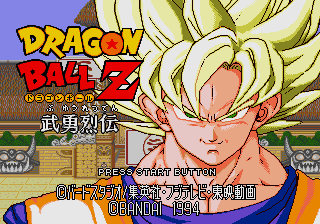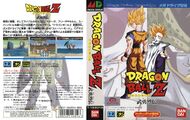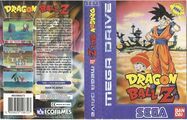Difference between revisions of "Dragon Ball Z: Buyuu Retsuden"
From Sega Retro
| Line 19: | Line 19: | ||
| genre=Action | | genre=Action | ||
}} | }} | ||
| − | '''''Dragon Ball Z: Buyuu Retsuden''''' (ドラゴンボールZ 武勇列伝) is a 1994 fighting game by [[Bandai]] for the [[Sega Mega Drive]] made with the ''[[wikipedia:Dragon Ball Z|Dragon Ball Z]]'' license released exclusively in Japan — and also France and Spain, due to the great popularity of the Dragon Ball Z anime in these European countries. The French/Spanish version was renamed '''''Dragon Ball Z: L'Appel du Destin''''' and has the game translated to French language and the instruction booklet | + | '''''Dragon Ball Z: Buyuu Retsuden''''' (ドラゴンボールZ 武勇列伝) is a 1994 fighting game by [[Bandai]] for the [[Sega Mega Drive]] made with the ''[[wikipedia:Dragon Ball Z|Dragon Ball Z]]'' license released exclusively in Japan — and also France and Spain, due to the great popularity of the Dragon Ball Z anime in these European countries. The French/Spanish version was renamed '''''Dragon Ball Z: L'Appel du Destin''''' and has the game translated to French language and the instruction booklet in French and Spanish languages. |
The game was also distributed in Portugal in 1996 where it is simply called '''''Dragon Ball Z'''''. The distributor, [[Ecofilmes]], would take Japanese copies of the game, replace the cover and the manual with Portuguese translated equivalents (but keep the Japanese cart), and sell the game as is, promising a free converter cart as the Japanese cartridges cannot fit into European Mega Drives. Some time after, they released a second version and switched to use the French version cartridge. Both versions are now very rare. | The game was also distributed in Portugal in 1996 where it is simply called '''''Dragon Ball Z'''''. The distributor, [[Ecofilmes]], would take Japanese copies of the game, replace the cover and the manual with Portuguese translated equivalents (but keep the Japanese cart), and sell the game as is, promising a free converter cart as the Japanese cartridges cannot fit into European Mega Drives. Some time after, they released a second version and switched to use the French version cartridge. Both versions are now very rare. | ||
Revision as of 14:05, 1 July 2014
This short article is in need of work. You can help Sega Retro by adding to it.
| Dragon Ball Z: Buyuu Retsuden | |||||
|---|---|---|---|---|---|
| System(s): Sega Mega Drive | |||||
| Publisher: Bandai, Ecofilmes (PT) | |||||
| Developer: Bandai | |||||
| Genre: Action | |||||
|
Dragon Ball Z: Buyuu Retsuden (ドラゴンボールZ 武勇列伝) is a 1994 fighting game by Bandai for the Sega Mega Drive made with the Dragon Ball Z license released exclusively in Japan — and also France and Spain, due to the great popularity of the Dragon Ball Z anime in these European countries. The French/Spanish version was renamed Dragon Ball Z: L'Appel du Destin and has the game translated to French language and the instruction booklet in French and Spanish languages.
The game was also distributed in Portugal in 1996 where it is simply called Dragon Ball Z. The distributor, Ecofilmes, would take Japanese copies of the game, replace the cover and the manual with Portuguese translated equivalents (but keep the Japanese cart), and sell the game as is, promising a free converter cart as the Japanese cartridges cannot fit into European Mega Drives. Some time after, they released a second version and switched to use the French version cartridge. Both versions are now very rare.
The game is a typical fighting game. ![]() punches,
punches, ![]() kicks,
kicks, ![]() jumps, and various combination moves can be done by holding the various controller buttons together. The
jumps, and various combination moves can be done by holding the various controller buttons together. The ![]() button is used to switch between staying on land and flying in the sky.
button is used to switch between staying on land and flying in the sky.
An unique feature in this game is that both characters will always be on-screen simultaneously — leading to the game doing vertical split-screen with scrolling, rotating split screen, and various other neat tricks the Mega Drive was not known for doing (accomplished using various tricks with VDP layer management). This feature is in fact required by some of the strongest moves (which require both players to be far away from each other).
Physical Scans
| Sega Retro Average | |||||||||||||||||||||||||||||||||||||||||||||||||||||||||||||||||||||||||||||||||||||||||
|---|---|---|---|---|---|---|---|---|---|---|---|---|---|---|---|---|---|---|---|---|---|---|---|---|---|---|---|---|---|---|---|---|---|---|---|---|---|---|---|---|---|---|---|---|---|---|---|---|---|---|---|---|---|---|---|---|---|---|---|---|---|---|---|---|---|---|---|---|---|---|---|---|---|---|---|---|---|---|---|---|---|---|---|---|---|---|---|---|---|
|
| 75 | |
|---|---|
| Based on 17 reviews | |
- ↑ 1700 igr dlya Sega, "" (RU; 2001-xx-xx), page 63
- ↑ Beep! MegaDrive, "May 1994" (JP; 1994-04-08), page 18
- ↑ Consoles +, "Mai 1994" (FR; 1994-0x-xx), page 90
- ↑ Hobby Consolas, "Junio 1994" (ES; 1994-xx-xx), page 110
- ↑ Joypad, "Mai 1994" (FR; 1994-0x-xx), page 44
- ↑ Mega, "July 1994" (UK; 1994-06-16), page 44
- ↑ Mega Force, "Mai 1994" (FR; 1994-0x-xx), page 28
- ↑ Mega Fun, "06/94" (DE; 1994-05-18), page 103
- ↑ MegaTech, "July 1994" (UK; 1994-06-16), page 44
- ↑ Mean Machines Sega, "July 1994" (UK; 1994-05-28), page 52
- ↑ Player One, "Juin 1994" (FR; 1994-0x-xx), page 32
- ↑ Sega Power, "August 1994" (UK; 1994-07-07), page 66
- ↑ Sega Pro, "August 1994" (UK; 1994-07-14), page 60
- ↑ Sega Zone, "June 1994" (UK; 1994-05-xx), page 16
- ↑ Sega Saturn Magazine, "September 1995" (JP; 1995-08-08), page 85
- ↑ Todo Sega, "Junio 1994" (ES; 1994-0x-xx), page 44
- ↑ Tricks 16 bit, "Tricks Sega Gold 800 igr" (RU; 1998-03-20), page 57



